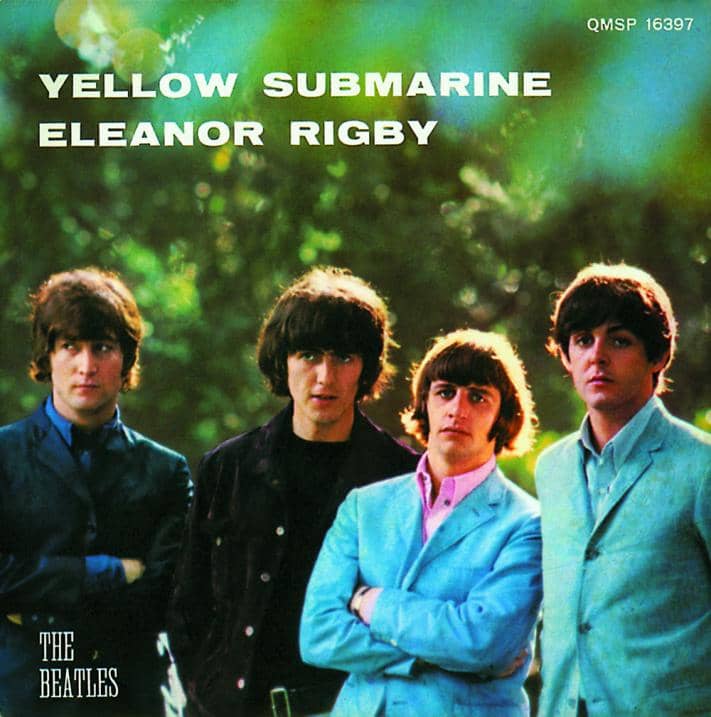Studio Two, EMI Studios, Abbey Road
Producer: George Martin
Engineer: Geoff Emerick
Having recorded the backing track on 26 May 1966, The Beatles and friends added sound effects and backing vocals for ‘Yellow Submarine’ on 1 June.
Two tracks were remaining on the tape, and The Beatles raided the trap room at Abbey Road to find suitable instruments and effects. Onto the first the following sounds were added, in rough order of appearance:
- John Lennon blowing bubbles into water using a straw
- George Harrison swirling water in a metal bathtub
- Two ships’ bells being rung
- A noisemaker being rattled
- Low-level voices for a party atmosphere
- An ocarina, played by The Rolling Stones’ Brian Jones (heard during the third verse)
- A propeller being wound and put into water
- Coins being scattered
- A foghorn
- The final singalong
The fourth track contained similar effects, again in the order in which they appear:
- Chains being rattled in the bathtub
- Clinking glasses
- More party chatter
- A brass band
- Lennon, recorded in the studio echo chamber, shouting naval phrases into a microphone connected to his Vox guitar amplifier. “Full speed ahead, Mr Boatswain, full speed ahead!”
- Whooshing sound effects
- Lennon’s “life of ease” vocals
- A marching band drum played by Mal Evans
The brass band was made up of session musicians booked especially for the session, although their names remain unknown. The final chorus, meanwhile, was sung by anyone on hand in the studio, including Mal Evans, Neil Aspinall, George Martin, Geoff Emerick, Pattie Harrison, Brian Jones, Marianne Faithfull, and The Beatles’ chauffeur Alf Bicknell.
Ringo Starr also recorded an unused introduction, a brief spoken word passage accompanied in part by the other Beatles:
…yellow submarine. And we will march till three the day to see them gathered there. From Land O’Groats to John O’Green, with Stepney do we tread. To see us yellow submarine. We love it.
The words were in reference to Land’s End and John O’Groats, the southernmost and northernmost parts of the United Kingdom. Underneath the vocals was the sound of a box of coal being shaken, in an approximation of marching feet.
This spoken passage was left out of the Revolver mixes, but was included on the ‘Real Love’ single in 1996. The new mix created for the single also brought many of the effects to the fore.
Also on this day...
- 2024: Ringo Starr and his All-Starr Band live: Venetian Theatre, Las Vegas
- 2019: Paul McCartney live: Rupp Arena, Lexington
- 2018: Ringo Starr and his All-Starr Band live: Music Box, Atlantic City
- 2008: Paul McCartney live: Liverpool Sound
- 2003: Paul McCartney live: King’s Dock, Liverpool
- 2000: Ringo Starr and his All-Starr Band live: Horseshoe Casino Tunica, Robinsonville
- 1981: US album release: Somewhere In England by George Harrison
- 1976: Wings live: Chicago Stadium, Chicago
- 1973: UK single release: Live And Let Die by Wings
- 1969: John Lennon and Yoko Ono record Give Peace A Chance
- 1969: John Lennon argues with Al Capp in Montreal
- 1969: George and Pattie Harrison holiday in Sardinia
- 1967: Recording: Untitled
- 1967: UK album release: Sgt Pepper’s Lonely Hearts Club Band
- 1964: Recording: Matchbox, I’ll Cry Instead, Slow Down, I’ll Be Back
- 1963: The Beatles live: Granada Cinema, Tooting, London
- 1963: Radio: Pop Go The Beatles
- 1961: The Beatles live: Top Ten Club, Hamburg
Want more? Visit the Beatles history section.

